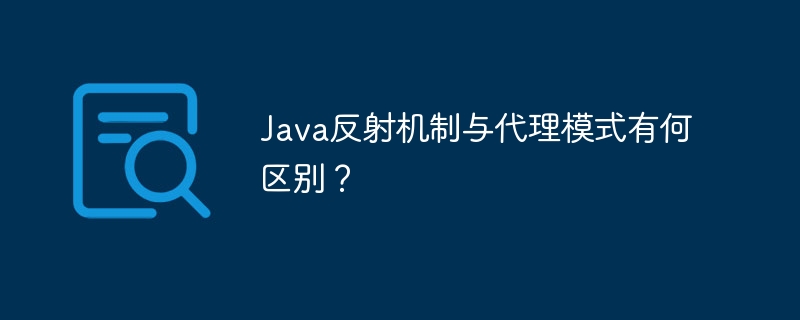The reflection mechanism is used to check and modify class attributes and methods, provide metadata access, and is mainly used for introspection and dynamic code generation; the proxy mode creates object avatars for object interaction intermediary, and implements AOP such as function enhancement and control access. focus point.

The difference between Java reflection mechanism and proxy mode
Introduction
Reflection mechanism and proxy patterns are powerful tools in Java for implementing dynamic programming techniques. However, there are key differences in their purpose and implementation.
Reflection mechanism
- Allows the properties and methods of a class to be inspected and modified at runtime.
- Provides metadata access to Java language structures.
- Mainly used for introspection, debugging and generating code.
Proxy Pattern
- Create a stand-in for an object in order to mediate interactions with it.
- Provides a way to decouple objects and client code.
- Used to enhance the functionality of an object, control access, or other AOP (aspect-oriented programming) concerns.
Technical implementation
Reflection mechanism:
// 获取 Class 对象
Class<T> cls = T.class;
// 获取属性和方法列表
Field[] fields = cls.getDeclaredFields();
Method[] methods = cls.getDeclaredMethods();
Copy after login
Agent mode:
// 创建代理调用句柄
InvocationHandler handler = new MyInvocationHandler();
// 创建代理对象
Object proxy = Proxy.newProxyInstance(cls.getClassLoader(), cls.getInterfaces(), handler);
Copy after login
Practical case
Reflection mechanism:
- Introspect a class: get its name, super class and interface .
- Modify private variables: Set the private boolean variable to true.
Proxy mode:
- Intercept method calls: execute custom logic before and after method execution.
- Control access: Restrict access to sensitive objects.
Key differences
-
Metadata access vs. behavior modification: The reflection mechanism is used to obtain information about the class, The proxy pattern is used to modify the behavior of objects.
-
Hidden implementation vs. public interface: The reflection mechanism needs to know the specific implementation of the class, while the proxy mode can enhance the behavior of the object without exposing the implementation.
-
Intrusive vs. non-intrusive: The reflection mechanism requires modification of the original class, while the proxy pattern provides non-intrusive enhancements by creating a proxy object.
The above is the detailed content of What is the difference between Java reflection mechanism and proxy mode?. For more information, please follow other related articles on the PHP Chinese website!


